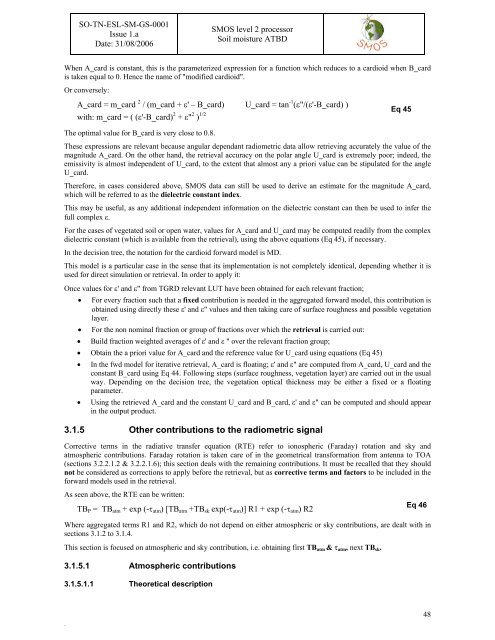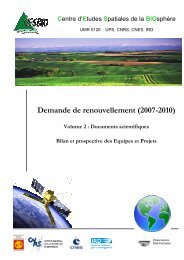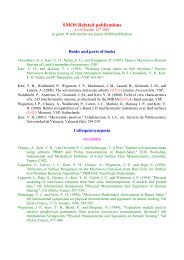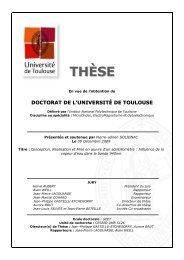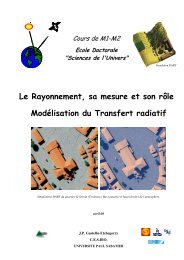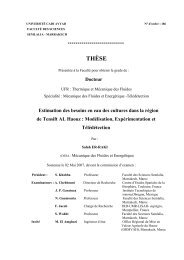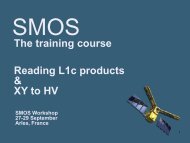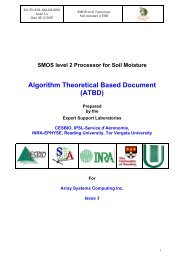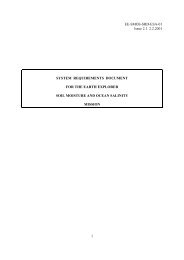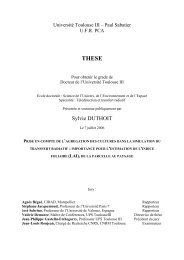Algorithm Theoretical Based Document (ATBD) - CESBIO
Algorithm Theoretical Based Document (ATBD) - CESBIO
Algorithm Theoretical Based Document (ATBD) - CESBIO
Create successful ePaper yourself
Turn your PDF publications into a flip-book with our unique Google optimized e-Paper software.
SO-TN-ESL-SM-GS-0001<br />
Issue 1.a<br />
Date: 31/08/2006<br />
SMOS level 2 processor<br />
Soil moisture <strong>ATBD</strong><br />
When A_card is constant, this is the parameterized expression for a function which reduces to a cardioid when B_card<br />
is taken equal to 0. Hence the name of "modified cardioid".<br />
Or conversely:<br />
A_card = m_card 2 / (m_card + ε' – B_card) U_card = tan -1 (ε"/(ε'-B_card) )<br />
Eq 45<br />
with: m_card = ( (ε'-B_card) 2 + ε" 2 ) 1/2<br />
The optimal value for B_card is very close to 0.8.<br />
These expressions are relevant because angular dependant radiometric data allow retrieving accurately the value of the<br />
magnitude A_card. On the other hand, the retrieval accuracy on the polar angle U_card is extremely poor; indeed, the<br />
emissivity is almost independent of U_card, to the extent that almost any a priori value can be stipulated for the angle<br />
U_card.<br />
Therefore, in cases considered above, SMOS data can still be used to derive an estimate for the magnitude A_card,<br />
which will be referred to as the dielectric constant index.<br />
This may be useful, as any additional independent information on the dielectric constant can then be used to infer the<br />
full complex ε.<br />
For the cases of vegetated soil or open water, values for A_card and U_card may be computed readily from the complex<br />
dielectric constant (which is available from the retrieval), using the above equations (Eq 45), if necessary.<br />
In the decision tree, the notation for the cardioid forward model is MD.<br />
This model is a particular case in the sense that its implementation is not completely identical, depending whether it is<br />
used for direct simulation or retrieval. In order to apply it:<br />
Once values for ε' and ε" from TGRD relevant LUT have been obtained for each relevant fraction;<br />
• For every fraction such that a fixed contribution is needed in the aggregated forward model, this contribution is<br />
obtained using directly these ε' and ε" values and then taking care of surface roughness and possible vegetation<br />
layer.<br />
• For the non nominal fraction or group of fractions over which the retrieval is carried out:<br />
• Build fraction weighted averages of ε' and ε " over the relevant fraction group;<br />
• Obtain the a priori value for A_card and the reference value for U_card using equations (Eq 45)<br />
• In the fwd model for iterative retrieval, A_card is floating; ε' and ε" are computed from A_card, U_card and the<br />
constant B_card using Eq 44. Following steps (surface roughness, vegetation layer) are carried out in the usual<br />
way. Depending on the decision tree, the vegetation optical thickness may be either a fixed or a floating<br />
parameter.<br />
• Using the retrieved A_card and the constant U_card and B_card, ε' and ε" can be computed and should appear<br />
in the output product.<br />
3.1.5 Other contributions to the radiometric signal<br />
Corrective terms in the radiative transfer equation (RTE) refer to ionospheric (Faraday) rotation and sky and<br />
atmospheric contributions. Faraday rotation is taken care of in the geometrical transformation from antenna to TOA<br />
(sections 3.2.2.1.2 & 3.2.2.1.6); this section deals with the remaining contributions. It must be recalled that they should<br />
not be considered as corrections to apply before the retrieval, but as corrective terms and factors to be included in the<br />
forward models used in the retrieval.<br />
As seen above, the RTE can be written:<br />
TB P = TB atm + exp (-τ atm ) [TB atm +TB sk exp(-τ atm )] R1 + exp (-τ atm ) R2<br />
Eq 46<br />
Where aggregated terms R1 and R2, which do not depend on either atmospheric or sky contributions, are dealt with in<br />
sections 3.1.2 to 3.1.4.<br />
This section is focused on atmospheric and sky contribution, i.e. obtaining first TB atm & τ atm , next TB sk .<br />
3.1.5.1 Atmospheric contributions<br />
3.1.5.1.1 <strong>Theoretical</strong> description<br />
.<br />
48


